American Journal of Plant Sciences
Vol.4 No.1(2013), Article ID:27641,19 pages DOI:10.4236/ajps.2013.41015
Ethnobotanical Study of Medicinal Plants of Semi-Tribal Area of Makerwal & Gulla Khel (Lying between Khyber Pakhtunkhwa and Punjab Provinces), Pakistan
![]()
1Department of Biological Sciences, University of Sargodha, Sargodha, Pakistan; 2University Wensam College Gomal University, Dera Imail Khan, Pakistan; 3Department of Botany, Institute of Chemical and Biological Sciences, University of Gujrat, Gujrat, Pakistan; 4Department of Chemistry, University of Sargodha, Sargodha, Pakistan; 5Department of Plant Sciences, Quaid-i-Azam University, Islamabad, Pakistan.
Email: *aminullahshah@gmail.com
Received October 7th, 2012; revised November 15th, 2012; accepted December 20th, 2012
Keywords: Ethnobotanical Study; Medicinal Plants; Makerwal & Gulla Khel; Pakistan
ABSTRACT
This paper is based on the results of an ethnomedicinal research work conducted in the semi-tribal mountainous area lying between District Mianwali (Punjab Province) and District Karak (Khyber Pakhtunkhwa Province), Pakistan during June 2009-July 2011. During field survey, questionnaires were used to interview the local inhabitants of the area. The ethnomedicinal data consists of 131 plant species (2 Pteridophytes, 7 Monocots, 122 Dicots) belonging to 48 families (2 Pteridophytes, 4 Monocots, 42 Dicots). The most commonly represented families were Amaranthaceae (9 spp.), Mimosaceae (8 spp.), Asteraceae and Papilionaceae (7 spp.) each; Solanaceae, Euphorbiaceae and Scrophulariaceae (6 spp.) each, followed by Boraginaceae, Brassicaceae, Lamiaceae and Polygonaceae (5 spp.) each. Plant specimens were identified, preserved and vouchers were deposited in the Plant Taxonomy Lab. of Department of Biological Sciences, University of Sargodha, Pakistan for future reference. The data collected through interviews with the local people indicates that these species are mostly used in respiratory tract infections (RTI), urinary tract infections (UTI), digestive disorders, sexual problems, skin diseases, liver ailments, wound healing, blood vomiting, malaria, piles, epilepsy, jaundice, gummosis, round worms, hepatitis etc. in the area. Due to lack of scientific approach regarding harvesting and utilization of this valuable medicinal flora, many plants are quickly going towards extinction; therefore, further work is needed to create awareness in the community conservation of the precious medicinal plants.
1. Introduction
Medicinal plants have been used since prehistoric period for the cure of various diseases. Since these are in common use by the local people and are of great importance that’s why a lot of people are engaged in the trade of important medicinal herbs throughout the world. Especially, people living in villages have been using indigenous plants as medicines [1].
Knowledge of medicinal values of plants is recognized by almost every society on earth. The inhabitants of the remote places have good knowledge about the utilization of plants because of the non-availability of synthetic drugs. In addition, for the survival, they use the plantbased drugs growing nearby their villages. Based on their right or wrong experiences they discovered the therapeutic agents of these plants in particular diseases. These experiences are transferred from parents to offspring [2].
In nearly every country of the world, treatment through herbs and some traditional medicine system is progressing. In Indo-Pak. Subcontinent, these traditional systems are called Unani or Ayurvedic system [1]. Ethnobotanical information is necessary to document the plant life in areas especially that are remote and un-explored [3].
In spite of the advent of the modern medicines, tribal populations are still relying on the art of herbal medicine [4]. Nearly about 80% of the world’s populations still depend upon traditional remedies together with folklore system mainly based on phytotherapy [5]. The ethnobotanical use of medicinal plants was transmitted from generation to generation [6]. Unfortunately, this traditional knowledge and transmission is in danger because transmission between older and younger generation is not always assured [7].
Makerwal & Gulla Khel Collieries are situated partly in Tehsil Isakhel, District Mianwali (Punjab Province) and partly in Tehsil Karak, District Karak (Khyber Pakhtunkhawa Province). The area under study was handed over to Pakistan Mineral and Development Corporation (PMDC) in October, 1978. The Makerwal & Gulla Khel is located at 32˚ - 52˚ North and 71˚ - 11˚ East Longitude and Latitude respectively with an elevation of 1063 feet and 1052 feet respectively above the sea level. The area is in Surghar Range of Tarna Indus Salt Range.
All the mountains have a huge wealth of coal (in addition to Iron, Uranium, Silica and Salt). The coal seam out crops at an average of height of 300 ft. The coal seam is in spite and dipping uniformly at 7˚ to 15˚ towards North. The coal seam is of ecceneage under overlying strata of 2500 ft. The coal seem is lenticular and range less than 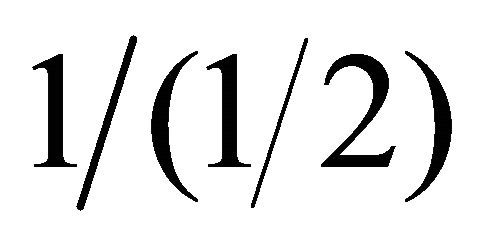 to 3 ft in thickness. The coal seam is dipping with an average angle of 13˚ due North. The overlying and under line strata of the coal seam is sand stone and with bands and shale. The mountainous areas display a scenic view (Figures 1 and 2).
to 3 ft in thickness. The coal seam is dipping with an average angle of 13˚ due North. The overlying and under line strata of the coal seam is sand stone and with bands and shale. The mountainous areas display a scenic view (Figures 1 and 2).
The climate of Makerwal & Gulla Khel is quite pleasant except a few months of summer. The area includes remote adjacent villages viz., Jatan Wala, Wanjari, Mala Khel, Maidan, Deeda Wal, Karandi, Kurrdi, Chashmia, Chapri, Kutki, Zairri, Katal wala, Sultan Khel, Mithha Khattak, inhabited by a number of castes and ethnic groups (namely: Khattak, Baloch, Mala Khel, Gulla Khel, Maidan Wall, Syed, Malik, Jats, Kumhar, Niazi etc). The economy of the people of the area is predominantly mining.
The traditional systems of the medicines like Unani in Pakistan are quite effective particularly in remote areas like Makerwal & Gulla Khel where Government supervision over health is almost zero.
Ethnobotanically, the research area is one of the least studied regions of Pakistan. Because of the specific geographic position and geographical features of the area and the negligence of Government to provide health facilities in the districts, the peoples are mostly dependent on the indigenous health care system. Local herbs and other plant resources found in the area are the principal source of medicine for the treatment of various human ailments [8].
The Present study is the first attempt to document the plant species in the area which was unexplored previously; secondly to hunt and record the ethnobotanical knowledge of the occurring plant species and thirdly to record the new or rare uses of medicinal plants in the area. Ethnobotanical research will made it possible to discover some phrmacologically active constituents from these medicinal plants in future. It is also hoped that these findings would provoke further pharmacological as well as phytochemical research in this remote area.
Ethnobotanically, the research area is one of the least
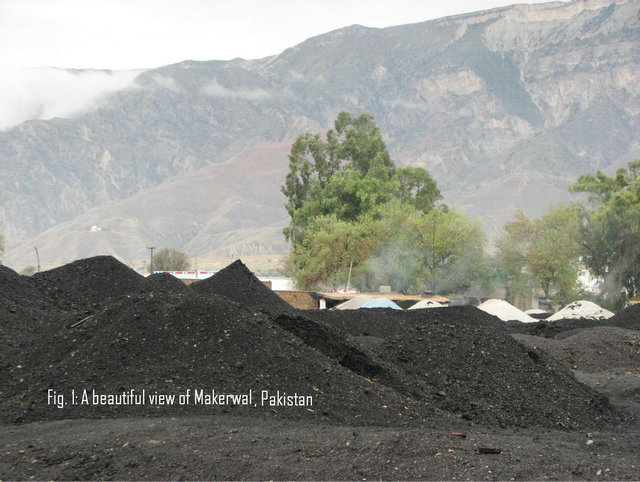
Figure 1. Makerwal collieries. Source: photos by author.
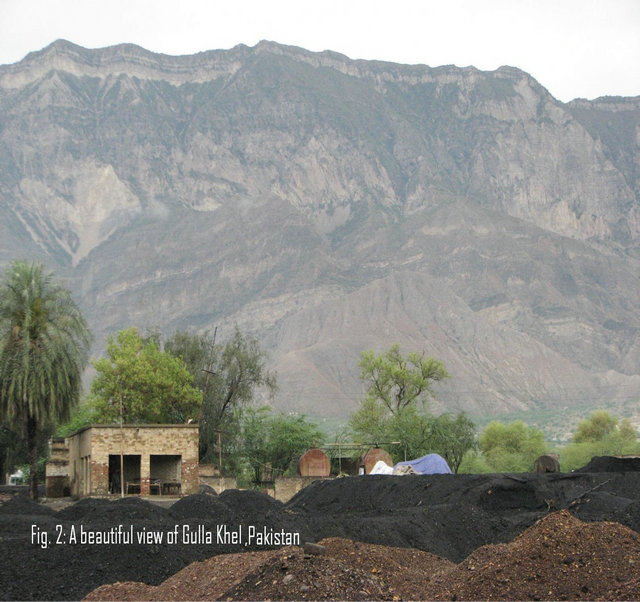
Figure 2. Gulla Khel collieries. Source: photos by author.
studied regions of Pakistan. Because of the specific geographic position and geographical features of the area and the negligence of Government to provide health facilities in the districts, the peoples are mostly dependent on the indigenous health care system. Local herbs and other plant resources found in the area are the principal source of medicine for the treatment of various human ailments [8].
The Present study is the first attempt to document the plant species in the area which was unexplored previously; secondly to hunt and record the ethnobotanical knowledge of the occurring plant species and thirdly to record the new or rare uses of medicinal plants in the area. Ethnobotanical research will made it possible to discover some phrmacologically active constituents from these medicinal plants in future. It is also hoped that these findings would provoke further pharmacological as well as phytochemical research in this remote area.
2. Materials and Methods
The research area was season wise extensively surveyed during June 2009-July 2011. Plant specimens were collected from various localities of the area. Data of the folk medicinal uses of indigenous plants was obtained through questionnaires and interviews. Those people particularly the old men and women were interviewed whose empirical knowledge was respected by everyone. The present study provides some additional uses of the species which are otherwise used in other areas. Collected plants were dried, pressed and mounted properly following Carter et al., 2007 [9]. The identification of the plants was done with the help of available literature [10-12] and by comparing with the authentic specimens available in the herbarium of Quaid-i-Azam University, Islamabad, Pakistan. After identification voucher specimens were deposited in the Plant Taxonomy Lab. of Department of Biological Sciences, University of Sargodha, Sargodha, Pakistan for future reference.
3. Results
The ethnomedicinal data consists of 131 plant species (2 Pteridophytes, 7 Monocots, 122 Dicots) belonging to 48 families (2 Pteridophytes, 4 Monocots, 42 Dicots). Among them 99 were herbs, 15 shrubs and 17 trees (Table 1). It is interesting to note that most of these plants were Dicots while Monocots and Pteridophytes constitute only a minor fraction of them. The most commonly represented families were Amaranthaceae (9 spp.
Table 1. Taxonomic information of medicinal plants of semi-tribal area Makerwal & Gulla Khel (lying between Khyber Pakhtunkhwa and Punjab Provinces), Pakistan.
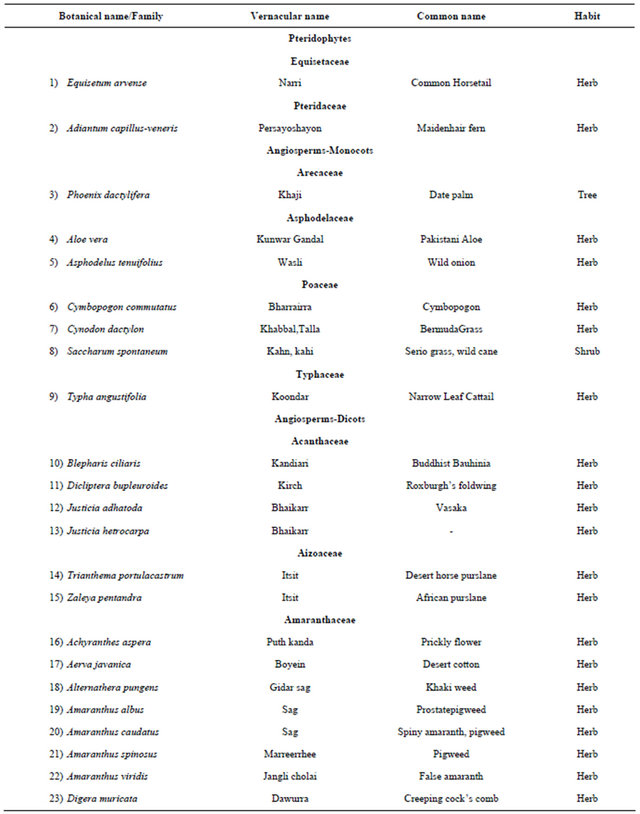
Continued
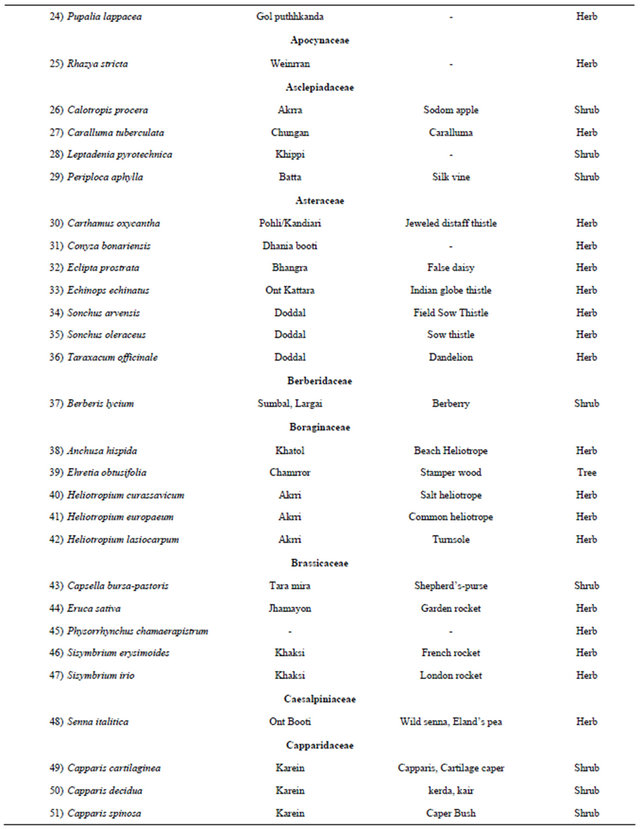
Continued
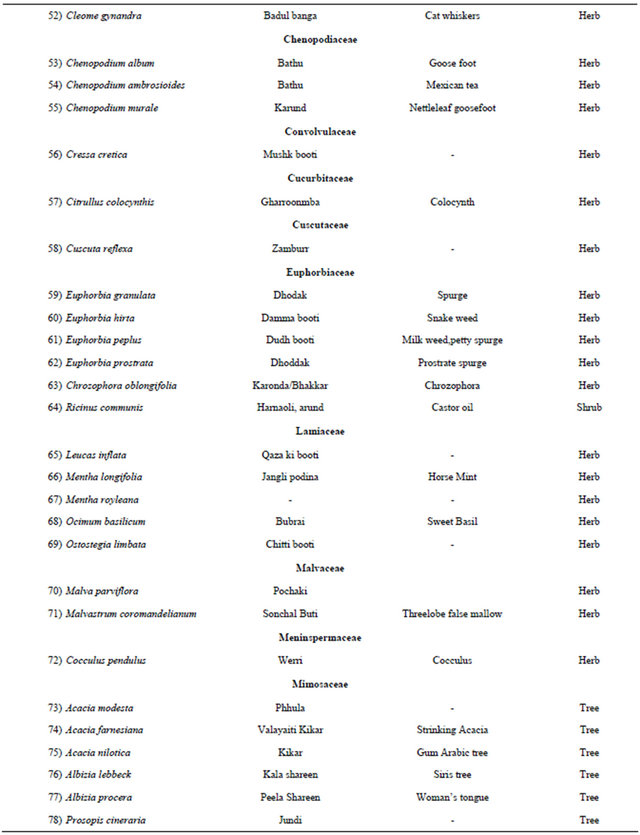
Continued
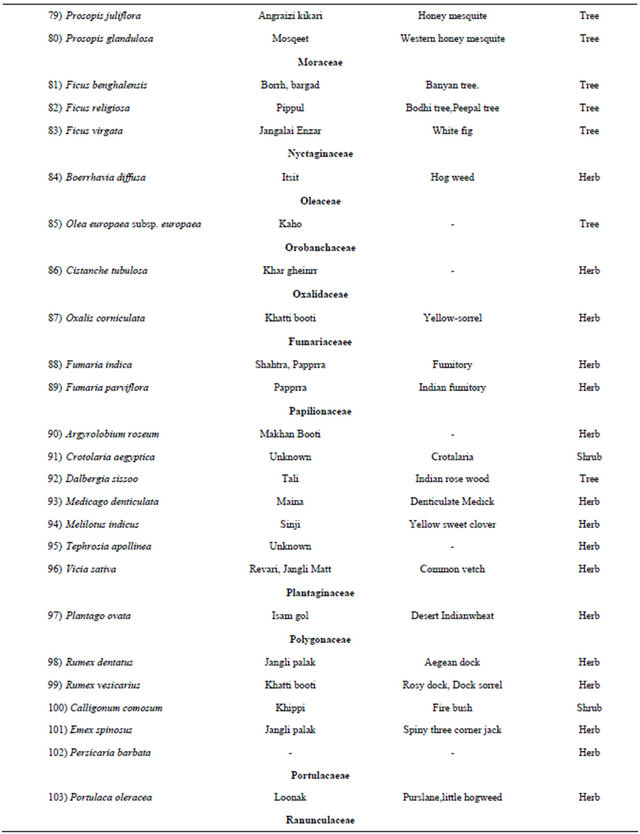
Continued
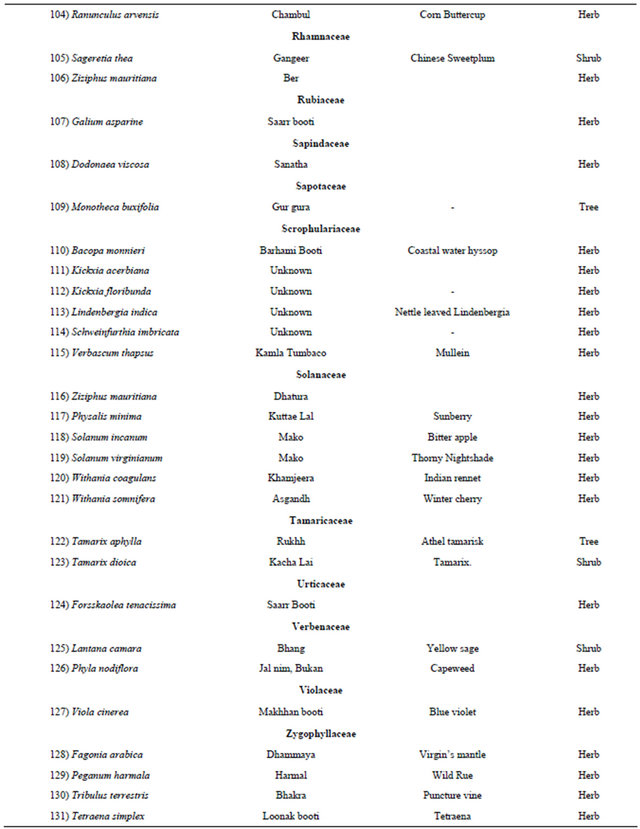
6.870%),), Mimosaceae (8 spp., 6.107%), Asteraceae and Papilionaceae (7 spp., 5.344%) each, Solanaceae, Euphorbiaceae and Scrophulariaceae (6 spp., 4.580%) each, Boraginaceae, Brassicaceae, Lamiaceae and Polygonaceae (5 spp., 3.817%) each followed by Acanthaceae, Asclepiadaceae, Capparidaceae, Chenopodiaceae and Zygophyllaceae (4 spp., 3.053%) each (Tables 1 and 2). The data collected through interviews with local people indicate that these species are mostly used in Respiratory Tract Infections (asthma, bronchitis, cold, cough, flu pulmonary congestion, sore throat etc.), Urinary Tract Infections (painful urination, bladder and kidney stone etc), digestive disorders (constipation, dysentery, diarrhea, dyspepsia, gastrointestinal infections etc.), sexual problems (gonorrhea, leucorrhoea, male sterility, menstrual cycle. Menstruation pain, spermatorrhoea etc.), skin ailments (skin allergy, skin rashes, leprosic skin, athlete’s foot disease, scabies etc), wound healing, blood vomiting, malaria, piles, epilepsy, jaundice, gummosis, round worms, hepatitis etc Data inventory constitutes botanical name, vernacular name, English name, family, parts used, habit and local uses. The plant parts frequently used to treat human’s health problems include root, stem and leaves. But due to illiteracy, the people are indulge in uprooting the plants with the result survival and continuity of useful medicinal plants are becoming impossible and hence their sustainable utilization is greatly affected. It was noted that these plant species were used by the peoples ethnobotanically since their forefathers for various purposes like medicine, fodder, fuel, timber, ornamental etc. Most of the plant species are used for multipurposes.
Enumeration of Plant Species
A. Pteridophytes
1) Adiantum capillus-veneris L. (Pteridaceae)
Part Used: Whole plant.
Local Uses: Decoction of the plant is used to cure all sorts of bronchial problems; frond extract is effective in removing spleen stones.
2) Equisetum arvense L. (Equisetaceae)
Part Used: Aerial plant.
Local Uses: Use it as a tea is helpful to remove stone from bladder and kidney; poultice of mashed plant is good to wound healing.
B. Angiosperms-Monocots
3) Aloe vera (L.) Burm.f. (Asphodelaceae)
Part Used: Leaves.
Local Uses: Leaves pulp is used to treat all kinds of skin infections; pulp as poultice is banded around the fractured bone to heal early; leaf pulp with sugar is used to treat diabetes.
4) Asphodelus tenuifolius Cavan (Asphodelaceae)
Part Used: Whole plant.
Local Uses: Seeds are diuretic; powered seeds when taken along with a glass of water early in the morning for three weeks are best remedy of piles.
5) Cymbopogon commutatus (Steud.) Stapf (Poaceae)
Part Used: Whole plant.
Local Uses: Plant stimulant; it’s shoots are used as tea to relieve from headache and fever.
6) Cynodon dactylon (L.) Pers. (Poaceae)
Part Used: Whole plant.
Local Uses: Infusion of roots and leaves is used to treat wounds; being diuretic in nature also used to treat kidney problems; also cure bronchial disorders.
7) Phoenix dactylifera L. (Arecaceae)
Part Used: Fruit.
Local Uses: Fruit is strongly aphrodisiac and tonic.
8) Saccharum spontaneum L. (Poaceae)
Part Used: Leaves.
Local Uses: Roots are astringent, emollient, diuretic and purgative effect and are used against dyspepsia, burning sensation and piles; Culm is useful against vitiated gall bladder.
9) Typha angustifolia L. (Typhaceae)
Part Used: Whole plant.
Local Uses: Dried crushed flowers are applied on the wounds and burns which has soothing effect and cooling effect.
C. Angiosperms-Dicots
10) Acacia modesta Wall. (Mimosaceae)
Part Used: Whole plant.
Local Uses: Best apiculture plant; young shoots are used as tooth brush; gum obtained from its bark along with sugar is used as tonic; also used to cure dysentery 11) Acacia farnesiana (L.) Willd. (Mimosaceae)
Part Used: Bark, pods.
Local Uses: Bark is used to treat toothache; decoction of pods is used to cure leucorrhoea and spermatorrhoea.
12) Acacia nilotica (L.) Delile (Mimosaceae)
Part Used: Whole plant.
Local Uses: Resin mixed with egg-white is applied to eyes as antimony to curecataract.
Infusion of leaves is drunk to treat diabetes; smoke of burning pods when inhaled, is used to treat cold; gum is used as aphrodisiac; pods as expectorant; bark decoction is used to cure digestives disorders; young shoots are rubbed on gums to cure gummosis.
13) Achyranthes aspera L. (Amaranthaceae)
Part Used: Whole plant.
Local Uses: The leaves extract along with water is used to cure dysentery; decoction of roots and leaves while infusion of roots is effective remedy of abdominal disorders; root paste is applied to lessen inflammation.
Table 2. Taxonomic information of medicinal plants of semi-tribal area Makerwal & Gulla Khel (lying between Khyber Pakhtunkhwa and Punjab Provinces), Pakistan.
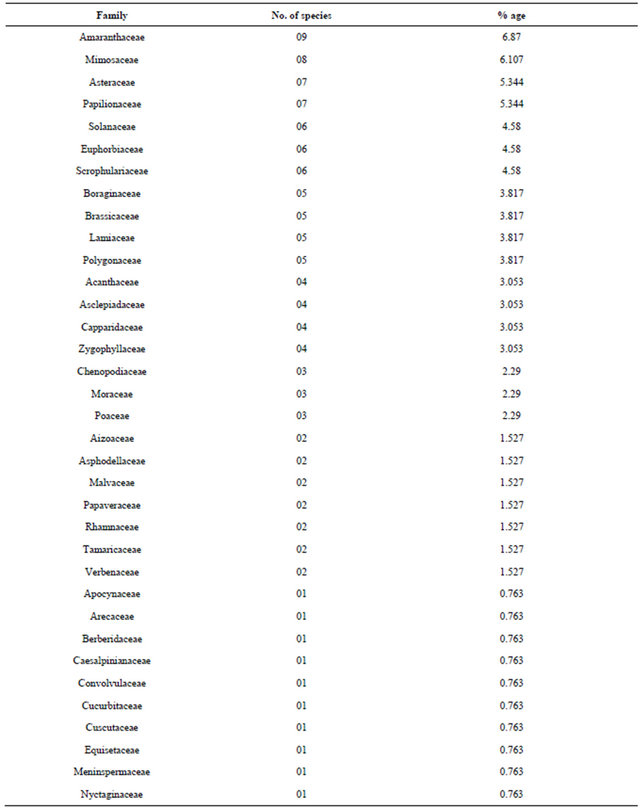
Continued
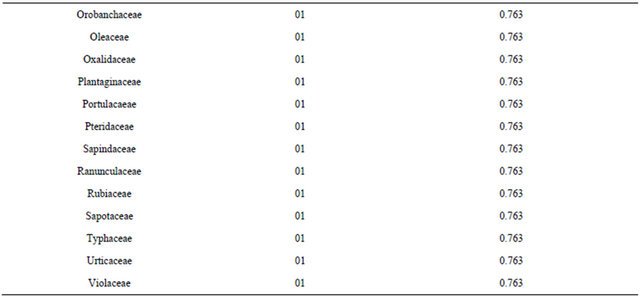
14) Aerva javanica (Burm.f.) Juss ex Schult. (Amaranthaceae)
Part Used: Whole plant.
Local Uses: Paste of flower with water is used on wound to stop and heel bleeding; root extract is used as eye drop; root ash is used as eye antimony (surma).
15) Albizia lebbeck (L.)Benth. (Mimosaceae)
Part Used: Whole plant.
Local Uses: A spoon of powdered seeds along with a glass of water, taken early in the morning up to three weeks is good treatment of diabetes; roots decoction is best for migraine treatment; oil extracted from its seeds is used to cure piles and skin ailments; dry flowers are used to treat male sterility.
16) Albizia procera (Roxb.) Benth (Mimosaceae)
Part Used: Whole plant.
Local Uses: Decoction of bark is used to treat bronchial problems; leaves poultice is used to treat any kind of ulcer; grown in front of courtyard to flee off mosquetoes and other harmful insects.
17) Alternathera pungens Kunth (Amaranthaceae)
Part Used: Whole plant.
Local Uses: Root decoction is remedy of gonorrhea; decoction of the plant (with little salt) is drink to stop blood vomiting; anti-malarial; remedy of urinary infections.
18) Amaranthus albus L. (Amaranthaceae)
Part Used: Whole plant.
Local Uses: Plant is cooked to get rid of constipation.
19) Amaranthus caudatus L. (Amaranthaceae)
Part Used: Whole plant.
Local Uses: Plant is cooked as vegetable along with Digera muricata and is considered as best blood purifier; its decoction is drink to treat pulmonary congestion.
20) Amaranthus spinosus L. (Amaranthaceae)
Part Used: Whole plant.
Local Uses: Plant possesses emollient properties and cooked as vegetable to promote urinary discharges; plant decoction is remedy of gonorrhoea.
21) Amaranthus viridis L. (Amaranthaceae)
Part Used: Whole plant.
Local Uses: Plant has astringent as well as emollient and vermifuge properties and cooked as a vegetable to treat constipation. Decoction of the plant is effective treatment of dysentery; roots decoction is good treatment of painful urination.
22) Anchusa hispida Forssk. (Boraginaceae)
Part Used: Whole.
Local Uses: Plant has astringent as well as emollient and vermifuge properties and cooked as a vegetable to treat constipation. Decoction of the plant is effective treatment of dysentery; roots decoction is good treatment of painful urination.
23) Argyrolobium roseum (Cambess.) Jaub. & Spach. (Papilionaceae)
Part Used: Whole plant.
Local Uses: Infusion of the herb taken early in the morning is strongly aphrodisiac; anti-diabetic.
24) Bacopa monnieri (L.) Pennell (Scrophuliraceae)
Part Used: Whole plant.
Local Uses: Plant has nerve, cardio-tonic properties as well as astringent, diuretic; plant is used as a treatment of epilepsy; leave juice is used as a remedy of bronchial and diarrheal ailments.
25) Berberis lycium Royle (Berberidaceae)
Part Used: Wood.
Local Uses: Decoction of wood with sugar is best treatment of jaundice.
26) Blepharis ciliaris (L.) B.L.Burtt (Acanthaceae)
Part Used: Roots, seeds.
Local Uses: Powdered seeds are applied on wounds and cuts for early healing and serve as anti-septic; dry, roasted powdered roots serve as substitute for antimony (surma) and improve vision.
27) Boerrhavia diffusa L. (Nyctaginaceae)
Part Used: Whole plant.
Local Uses: Young branches are cut in to small pieces and are hung around the neck in the form of a necklace as a best treatment of jaundice; regulate menstrual cycle.
28) Calligonum comosum L’ Her. (Polygonaceae)
Part Used: Whole plant.
Local Uses: Leaves and stems are chewed to wash teeth and to treat gummosis; young shoots infusion is used as tonic.
29) Calotropis procera (Aiton) W.T.Aiton. (Asclepiadaceae)
Part Used: Whole plant.
Local Uses: Latex is used to treat all kinds of skin ailments; toothache; dried leaves Under shade are smoked to treat asthma; powdered of leaves in small quantities taken internally to removes round worms.
30) Capparis cartilaginea Decne. (Capparidaceae)
Part Used: Whole plant.
Local Uses: Latex is used to treat all kinds of skin ailments; toothache; dried leaves under shade are smoked to treat asthma; powdered of leaves in small quantities taken internally to removes round worms.
31) Capparis decidua (Forssk.) Edgew (Capparidaceae)
Part Used: Fruit.
Local Uses: Fruit has astringent properties and useful in cardiac problems while roots have expectorant properties and useful in bronchial disorders.
32) Capparis spinosa L. (Capparidaceae)
Part Used: Fruit.
Local Uses: Decocted leaves oil serve as ear drop; leaves along with leaves of Rhazya stricta is used as a treatment of diabetes; pudding of honey and its fruit a best treatment of sciatica; seeds are eaten to lessen menstruation pain.
33) Capsella bursa-pastoris (L.) Medik. (Brassicaceae)
Part Used: Whole plant.
Local Uses: Crushed leaves that is considered as anti-septic, heated in water and used as poultices on wounds, bruises and boils are good remedy of their healing; paste of stem and leaves as poultice on inflamed joints serve as pain killer.
34) Caralluma tuberculata N.E.Br. (Asclepiadaceae)
Part Used: Whole plant.
Local Uses: Pounded and drink in the form of tea to cure liver ailments, high blood pressure and diabetes.
35) Carthamus oxycantha M.Bieb. (Asteraceae)
Part Used: Whole plant.
Local Uses: Flowers decoction is used to treat male infertility; also to treat jaundice; Oil extracted from seeds is tonic as well as used to cure scabies.
36) Chenopodium album L. (Chenopodiaceae)
Part Used: Whole plant.
Local Uses: Plant has anthelmintic, diuretic as well as laxative properties and contains Vitamin C; cooked as vegetable and cure urinary disorders; decoction of roots is effective against jaundice.
37) Chenopodium ambrosiodes L. (Chenopodiaceae)
Part Used: Whole plant.
Local Uses: Plant has anthelmintic and carminative; cooked as vegetable; decoction is effective treatment of round worms.
38) Chenopodium murale L. (Chenopodiaceae)
Part Used: Whole plant.
Local Uses: Plant has anthelmintic, diuretic, emollient and purgative; cooked as vegetable and tonic to liver; treat dyspepsia and effective against vitiated gall balder.
39) Chrozophora oblongifolia (Del) A. Juss. ex Spreng. (Euphorbiaceae)
Part Used: Fruit.
Local Uses: Plant has emetic and cathartic nature; fruit has wound-healing properties and poultice of fruit is effective healer.
40) Cistanche tubulosa (Schrenk) Wight (Orobanchaceae)
Part Used: Whole plant.
Local Uses: Decoction of the plant is used to cure diarrhea; pudding of dried plant along with camel milk is best treatment of contusions; also aphrodisiac.
41) Citrullus colocynthis (L.) Schrad. (Cucurbitaceae)
Part Used: Fruit.
Local Uses: Powdered leaves mixed with water are laxative while root and seed have purgative nature; one seed taken early in the morning for three weeks is good to cure diabetes.
42) Cleome gynandra L. (Capparidaceae)
Part Used: Fruit.
Local Uses: Plants has anthelmintic properties; decoction of the plant is good remedy of gastrointestinal infections and gastric problems.
43) Cocculus pendulus (J. R. & G. Forst) Diels (Meninspermaceae)
Part Used: Whole plant.
Local Uses: Decoction of leaves is used to treat constipation.
44) Conyza bonariensis (L.) Cronq. (Asteraceae)
Part Used: Whole plant.
Local Uses: Plant has astringent and diuretic properties; plant is effective against dysentery and diarrhea.
45) Cressa cretica L. (Convolvulaceae)
Part Used: Whole plant.
Local Uses: Decoction of the plant is used as tonic and aphrodisiac; also serve as expectorant; powder of dried leaves along with sugar is good remedy of jaundice.
46) Crotolaria aegyptica Benth. (Papilionaceae)
Part Used: Whole plant.
Local Uses: Plant has astringent and diuretic properties; plant is effective against dysentery and diarrhea.
47) Cuscuta reflexa Roxb. (Cucutaceae)
Part Used: Whole plant.
Local Uses: Plant is purgative in nature; extract of the plant along with Saccharum officinarum juice is drunk to treat jaundice.
48) Dalbergia sissoo Roxb. ex DC. (Papilionaceae)
Part Used: Root, Leaves.
Local Uses: Decoction of the root is used to cure discharge of blood along the faeces; while that of leaves is used as a treatment of gonorrhoea.
49) Datura metel L. (Solanaceae)
Part Used: Whole plant.
Local Uses: Dried leaves and flowers are smoked as a treatment of asthma; seeds in trace doses give pain relief.
50) Dicliptera bupleuroides Nees. (Acanthaceae)
Part Used: Whole plant.
Local Uses: Decoction of the plant serves as tonic; leaves pastes is treatment of eczema; leave extract also used as an ear drop.
51) Digera muricata (L.) Mart. (Amaranthaceae)
Part Used: Whole plant.
Local Uses: Plant is diuretic and laxative in nature; cooked as vegetables along with Chenopodium viridus; its decoction is effective to cure urinary problems.
52) Dodonaea viscosa Jacq. (Sapindaceae)
Part Used: Whole plant.
Local Uses: Mashed leaves placed on the ill teeth lessen pain; poultice of leaves and fruit together is used to treat sore muscles.
53) Eclipta prostrata L. (Asteraceae)
Part Used: Whole plant.
Local Uses: Infusion of the plant is used as gargle; leaves are useful in liver disorders and jaundice as well as in spleen enlargement.
54) Echinops echinatus Roxb. (Asteraceae)
Part Used: Whole plant.
Local Uses: Plant seeds are used to treat liver ailments; powdered roots with honey are taken to relieve bronchial disorders; flower juice is used as eye drop.
55) Ehretia obtusifolia Hoscht. ex DC. (Boraginaceae)
Part Used: Whole plant.
Local Uses: Infusion of leaves is best treatment of sore throat; while using leaves as tooth brush is beneficial to gummosis and toothache; decoction of roots is best remedy of removal of placental remains; powdered roots along with porridge are quite effective to lessen the pain during menses.
56) Emex spinosus (L.) Campd. (Polygonaceae)
Part Used: Aerial plant.
Local Uses: Use it as a tea is helpful to remove stone from bladder and kidney; poultice of mashed plant is good to wound healing.
57) Eruca sativa Mill. (Brassicaceae)
Part Used: Leaves.
Local Uses: Decoction of leaves is drunk as soup to treat dyspepsia and constipation.
58) Euphorbia granulata Forssk. (Euphorbiaceae)
Part Used: Whole plant.
Local Uses: Latex is antidote to any kind of bite.
59) Euphorbia hirta L. (Euphorbiaceae)
Part Used: Whole plant.
Local Uses: Decoction of the plant is used as treatment of asthma, bronchitis and cough; also cure measles and athlete’s foot disease.
60) Euphorbia peplus L. (Euphorbiaceae)
Part Used: Whole plant.
Local Uses: Extract of the plant is useful in all kinds of liver ailments; latex has purgative and purgative properties; latex is used as a treatment of asthma and joint pains.
61) Euphorbia prostrata Aiton. (Euphorbiaceae)
Part Used: Whole plant.
Local Uses: Same as Euphorbia peplus.
62) Fagonia arabica L. (Zygophyllaceae)
Part Used: Whole plant.
Local Uses: Powdered roots and leaves are used as a treatment of colic; decoction of plant is used to wash venereal diseases; root decoction serve as anti-cancer.
63) Ficus benghalensis L. (Moraceae)
Part Used: Whole plant.
Local Uses: Roots, bark and latex are used to treat diabetes and leucorrhea; fruit and latex is aphrodisiac and blood purifier; dry seeds have anti-inflammatory nature.
64) Ficus religeosa L. (Moraceae)
Part Used: Root, leaves.
Local Uses: Roots are used as tooth brush to treat gummosis; leave infusion is used to treat constipation while that of bark is used to treat scabies.
65) Ficus virgata Wall. ex Roxb. (Moraceae)
Part Used: Fruit.
Local Uses: Fruit is used to treat lungs and gall bladder ailments; decoction of leaves in milk is used to treat blood pressure.
66) Forsskaolea tenacissima L. (Urticaceae)
Part Used: Whole plant.
Local Uses: Infusion of the plant is used to cure headache and fever.
67) Fumaria indica (Hausskn) Pugsl. (Papaveraceae)
Part Used: Whole plant.
Local Uses: Decoction of the plant is used as a remedy of blood purification.
68) Fumaria parviflora Lam. (Papaveraceae)
Part Used: Whole plant.
Local Uses: Decoction of the plant is used as a remedy of blood purification; plant extract is used to treat intestinal worms; paste of the plant is applied to cure skin rashes.
69) Galium asparine L. (Rubiaceae)
Part Used: Whole plant.
Local Uses: The plant has diuretic and laxative properties; decocted of the plant cleanse the blood.
70) Heliotropium curassavicum L. (Boraginaceae)
Part Used: Whole plant.
Local Uses: Plant is used as anti-septic to kin ailments.
71) Heliotropium europaeum L. (Boraginaceae)
Part Used: Whole plant.
Local Uses: Oil roasted in the plant serve as balm on leprosic skin.
72) Heliotropium lasiocarpum Fisch & C.A.Mey. (Boraginaceae)
Part Used: Whole plant.
Local Uses: Leaves are used as tea, and the tea is good remedy of liver ailments and has emetic properties.
73) Justicia adhatoda L. (Acanthaceae)
Part Used: Whole plant.
Local Uses: Leaves and roots decoction is used in bronchial ailments; vegetative buds are used for the treatment of diabetes.
74) Justicia hetrocarpa T. Anderson (Acanthaceae)
Part Used: Whole plant.
Local Uses: Decoction of the plant is used to cure bronchial disorders.
75) Kickxia acerbiana (Boiss)Takh & Boulos (Scrophulariaceae).
Part Used: Whole plant Local Uses: Infusion of the plant is used to cure malaria 76) Kickxia floribunda (Boiss)Takh & Boulos (Scrophulariaceae)
Part Used: Whole plant.
Local Uses: Crushed plant is used as poultice on sting bite.
77) Lantana camara L. (Verbenaceae)
Part Used: Whole plant.
Local Uses: Decoction of the plant is used as a remedy of malaria and as antiseptic while infusion of leaves is used as an alternative of Brufen.
78) Leptadenia pyrotechnica (Forssk.) Decne (Asclepiadaceae)
Part Used: Stem.
Local Uses: Infusion of stem is diuretic.
79) Leucas inflata Benth. (Lamiaceae)
Part Used: Whole plant.
Local Uses: Infusion of stem is diuretic.
80) Lindenbergia indica (L.) Vatke (Scrophulariaceae)
Part Used: Whole plant.
Local Uses: Decoction of the plant is used to cure chronic bronchitis.
81) Malva parviflora L. (Malvaceae)
Part Used: Leaves, seeds.
Local Uses: Infusion of leaves and skin is used to lessen skin allergy and as diaphoretic; also cure headache when used as gargle.
82) Malvastrum coromandelianum L. (Malvaceae)
Part Used: Whole plant.
Local Uses: Flowers decoction is used to reduce fever; decoction of whole plant is used to treat dysentery; poultice of leaves is used to heal wounds.
83) Medicago denticulata Willd. (Papilionaceae)
Part Used: Whole plant.
Local Uses: Plant is expectorant and used as decoction to cure bronchial diseases.
84) Melilotus indicus (L.) All. (Papilionaceae)
Part Used: Whole plant.
Local Uses: Infusion and decoction is used in cough and bronchial disorders; expectorant; infusion of flowers is used to cure abdominal cramps; seeds are taken to treat genital diseases.
85) Mentha royleana Benth. (Lamiaceae)
Part Used: Whole plant.
Local Uses: Decoction of the plant is used to cure stomach problems.
86) Mentha longifolia (L.) Huds. (Lamiaceae)
Part Used: Whole plant.
Local Uses: Powdered plant is eaten after meal to treat gas problems in stomach; infusion of the plants is used to cure fever.
87) Monotheca buxifolia (Falc.) A. DC. (Sapotaceae)
Part Used: Fruit.
Local Uses: Fruit is anthelmintic; by an average eating one Kg of fruit, every kind of worm infestation can be eliminated from the body; gum of the tree is used as antimony and can cure eye infection.
88) Olea europaea subsp. europaea L. (Oleaceae)
Part Used: Fruit.
Local Uses: Fruit are strongly anthelmintic. If about one kilogram is eaten, the body will be freed from any kind of worms. Fruit also has anti-diabetic nature. Young shoots are used as tooth brush to get rid off from toothache.
89) Ocimum basilicum L. (Lamiaceae)
Part Used: Whole plant.
Local Uses: Fragrances when smelled cure headache; crushed leaves are placed in nose to treat cold; leaves extract is used as ear drop; leaves are used as salad to treat stomachache.
90) Ostostegia limbata (Benth.) Boiss. (Lamiaceae)
Part Used: Whole plant.
Local Uses: Gargle of the decoction is useful treatment of oral cavity problems; plant is of anti-septic nature.
91) Oxalis corniculata L. (Oxalidaceae)
Part Used: Whole plant.
Local Uses: Roots are anthelmintic; Juice of the plant is antidote to herbal toxicity; plants possess anti-septic properties.
92) Peganum harmala L. (Zygophyllaceae)
Part Used: Whole plant.
Local Uses: A spoon of powdered seeds taken early in the morning for three weeks is effective remedy of piles; fumigation of shade-dry plant is best treatment of measles; bath with roots decocted water serve as anti-lice shampoo.
93) Periploca aphylla Decne. (Asclepiadaceae)
Part Used: Whole plant.
Local Uses: Latex is good remedy of skin ailments specially healing of wounds; decoction of plant is used to cure fever and headache.
94) Persicaria barbata (L.) H. Hara (Polygonaceae)
Part Used: Whole plant.
Local Uses: Plant has astringent and cooling nature; powdered seeds taken along with water are remedy of colic; poultice of root are used as remedy for scabies.
95) Phyla nodiflora (L.) Greene (Verbenaceae)
Part Used: Whole plant.
Local Uses: Decoction of the plant is used as cooling agent; effective against venereal disease; washing of hair with decocted water serve as dandruff shampoo; anthelmintic; infusion of the plant is helpful to cure bronchial disorders.
96) Physalis minima L. (Solanaceae)
Part Used: Whole plant.
Local Uses: Plant is anti-cancerous; Fruit is tonic; juice of leaves serve as ear drop; diuretic.
97) Physorrhynchus chamaerapistrum (Boiss)Boiss. (Brassicaceae)
Part Used: Leave, stem, seed.
Local Uses: Leaves and stem extract is used as ear drop; powdered of seeds mixed with milk is applied on boils to heal quickly. Leaves paste is used to treat wounds with pus.
98) Plantago ovata Forssk. (Plantaginaceae)
Part Used: Seed.
Local Uses: Seeds husk along with curd is best treatment of intestinal and gastric disorders; powdered seeds mixed with water are used to treat venereal diseases; poultice of soaked seeds is used to treat boils and ulcer.
99) Portulaca oleracea L. (Portulacaeae)
Part Used: Leaves.
Local Uses: Plant has anthelmintic, laxative and diuretic properties; leaves as poultice are applied on skin to remove pus; cooked as vegetable to treat diarrhea and dysentery.
100) Prosopis cineraria (L) Druce (Mimosaceae)
Part Used: Whole plant.
Local Uses: Powder of dry pods and Ocimum basilicum mixed with lemon juice is used as antimony on eyes to treat cataract; extract of leaves as well as green pods serves as eye drop; bark ash along with water when applied on injuries, soothing is felt; bark decoction is treatment of rheumatism; sap of branches is used as anti-septic.
101) Prosopis juliflora (Sw) DC. (Mimosaceae)
Part Used: Leaves.
Local Uses: The juice of the leaves has anti-cancerous effect by reducing superfluous flesh.
102) Prosopis glandulosa Torr. (Mimosaceae)
Part Used: Leaves.
Local Uses: Dried gum is used as antimony to cure eye infections; a poultice of leaves is used to cure red ant stings.
103) Pupalia lappacea (L.) Juss. (Amaranthaceae)
Part Used: Leaves.
Local Uses: The plant is remedy of leprosy; poultice of leaves is used on fractured bone to heal quickly.
104) Ranunculus arvensis L.
Family: Ranunculaceae.
Part Used: Whole plant.
Local Uses: Decoction of the plant is used as a remedy of malaria.
105) Rhazya stricta Decne. (Apocynaceae)
Part Used: Whole plant.
Local Uses: Decoction of the plant is used as a remedy of chronic wounds; treatment of diabetes along with Withania coagulans.
106) Ricinus communis L. (Euphorbiaceae)
Part Used: Seed.
Local Uses: Seed is used as contraceptive; seed is purgative; seeds are taken as contraceptive; oil extracted from seeds is used to easy delivery and to lessen labour pain.
107) Rumex dentatus L. (Polygonaceae)
Part Used: Root, seed.
Local Uses: Roots are astringent in nature; seeds have aphrodisiac properties.
108) Rumex vesicarius L. (Polygonaceae)
Part Used: Leaves.
Local Uses: Leaves are eaten in raw form to treat liver ailments; cooked as vegetable to cure constipation and to treat dyspepsia.
109) Sageretia thea (Osbeck) M. C. Johnst. (Rhamnaceae)
Part Used: Whole plant.
Local Uses: Root and stem are used for treatment of hepatitis.
110) Schweinfurthia imbricata A. Miller (Scrophulariaceae)
Part Used: Whole plant.
Local Uses: Twigs are chewed to treat gummosis; dried powdered leaves are applied to wounds and ulcers to heal; dried fruit cooked with sugar are taken to regulate menses.
111) Senna italitica Mill. (Caesalpiniaceae)
Part Used: Leaves, seeds.
Local Uses: Powdered leaves and seeds and sugar are mixed in lemon juice and filtered; the use of this extract is best treatment of constipation.
112) Sisymbrium erysimoides Desf. (Brassicaceae)
Part Used: Whole plant.
Local Uses: Plant is expectorant and its decoction is used against bronchial disorders.
Leaves infusion is also quite effective remedy of sore throat.
113) Sisymbrium irio L. (Brassicaceae)
Part Used: Whole plant.
Local Uses: Same as Sisymbrium erysimoides.
114) Solanum incanum L. (Solanaceae)
Part Used: Whole plant.
Local Uses: Plant is anti-septic and analgesic properties and decocted water of this plant is used to cure cutaneous ailments.
115) Solanum virginianum L. (Solanaceae)
Part Used: Whole plant.
Local Uses: Plant powder is used internally to treat cough, asthma, bronchitis and chest affections; root decoction is best expectorant; fruit juice is used as a treatment of sore throat.
116) Sonchus arvensis L. (Asteraceae)
Part Used: Whole plant.
Local Uses: The plant has diaphoretic, antiseptic and expectorant; plant decoction is used to treat bronchial disorders.
117) Sonchus oleraceus L. (Asteraceae)
Part Used: Whole plant.
Local Uses: Infusion of the plant serves as laxative, tonic and diuretic.
118) Tamarix aphylla (L.) Karst. (Tamaricaceae)
Part Used: Leaves.
Local Uses: Dried leave powder’s decoction is used to treat prolong labour; dried powdered leaves are used a poultice to heal the wounds due to saddle sores and rope burns. Smoke of dry leaves is given to children caught by measles for early recover.
119) Tamarix dioica Roxb. ex Roth (Tamaricaceae)
Part Used: Whole plant.
Local Uses: Same as Tamarix aphylla (L.) Karst.
120) Taraxacum officinale L. (Asteraceae)
Part Used: Whole plant.
Local Uses: Plant is diuretic, laxative in nature; decoction of the plant is remedy of urinary disorders.
121) Tephrosia apollinea (Delile)DC. (Papilionaceae)
Part Used: Whole plant.
Local Uses: Decoction of the plant is used as ear drop; paste of powdered leaves when used as poultice on wounds, it lessen pain and heal quickly.
122) Tetraena simplex (L.) Beier & Thulin (Zygophyllaceae)
Part Used: Whole plant.
Local Uses: Plant is useful to cure cold, flu, cough; also has vermifuge properties; used as eye drop; cure heart diseases.
123) Trianthema portulacastrum L. (Aizoaceae)
Part Used: Shoots.
Local Uses: Shoots are cut in to small pieces and are made into necklace and are hung around the neck to cure jaundice.
124) Tribulus terrestris L. (Zygophyllaceae)
Part Used: Whole plant.
Local Uses: Plant is cooling, aphrodisiac, diuretic and tonic properties; decoction is used to normalize abnormal discharge of renal and urethral discharges; also treat oral inflammations and bladder disorders.
125) Verbascum thapsus L. (Scrophulariaceae)
Part Used: Whole plant.
Local Uses: Plant has anti-septic, anthelmintic, aphrodisiac and analgesic properties.
Decoction of root is used to cure migraine; the spray of powder of leaves on wounds helps in quick healing. Seeds infusion is used as narcotic and aphrodisiac.
126) Vicia sativa L. (Papilionaceae)
Part Used: Whole plant.
Local Uses: Powder of the plant dissolve in bathing water, cleans the dandruff.
127) Viola cinerea L. (Violaceae)
Part Used: Whole plant.
Local Uses: Infusion of the plant is best treatment of spermatorrhoea while decoction of the plant serve as blood purifier.
128) Withania coagulans (Stock.) Dunal (Solanaceae)
Part Used: Whole plant.
Local Uses: Plant is best blood purifier; fruit is used for liver complaints; decoction of fruit is best remedy for any kind of skin diseases; anti-diabetic plant.
129) Withania somnifera (L.) Dunal (Solanaceae)
Part Used: Whole plant.
Local Uses: Plant is diuretic, astringent, diaphoretic, aphrodisiac and tonic in nature; extract of the plant is used to treat rheumatism; poultice of leaves on burns has soothing effect; root powder has infertility effect; crushed leaves along with berries in water, given at the time of labour make the birth easy.
130) Zaleya pentandra (L.) C. Jeffrey (Aizoaceae)
Part Used: Shoot.
Local Uses: Same as Trianthema portulacastrum.
131) Ziziphus mauritiana Lam. (Rhamnaceae).
Part Used: Shoot.
Local Uses: Decoction of leaves is used as shampoo; crushed leaves along with lemon juice are applied on face to remove pimples; ash wood mixed in vinegar is applied to snake bite; tea of dried fruit is used to treat measles; decoction of the fruit is used to treat bronchial disorders.
4. Discussion
The significance of plants is all pervasive. Chaudhary (1961) surveyed that in Pakistan, there are about 1500 species of medicinal plants that are used to cure various ailments [13]. Up to 1950, 84% of Pakistan population was dependent on traditional medicines for all or most of their medicinal needs [14]. According to WHO, 80% of population of developing countries rely on medicinal plants for health care. Modern pharmacopoeia still contains at least 25% drugs derived from plants. Due to growing recognition of natural products, demands for medicinal plants are increasing in the socio-cultural and spiritual arenas, especially of rural Pakistan. The scope of medicinal plants is gigantic and can revolutionize the lives of the people in the rural areas of Pakistan where many wild species still found and flourishing [15].
The study area is considered as the most remote area of Pakistan with lofty mountains and with scattered flora; many of which are still unexplored from taxonomic and medicinal point of view. Information on the folk use of the plants reported in this study is based on the personal observations; first-hand field notes and material gathered from reliable informants who have long been using these herbal remedies since their forefathers in their health care. Most of the remedies consist of a single plant species. However, in many cases recipes are made up of two to three different plant species like Withania coagulans and Rhazya stricta are together used to treat chronic wounds and diabetes and sometimes ingredient of non-plant origin (like salt, honey, oil etc), e.g., Ziziphus mauritiana along with lemon juice and vinegar is used to treat skin ailments and snake bite. Moreover, the same plant species can be used as a treatment of more than one diseases like Rumex vesicarius and Emex spinosus is used to treat not only liver ailments but also digestive disorders and a single disease may be cured by two different species, e.g., Citrullus colocynthis, Rhazya stricta, Albizia lebbeck, all are ethnobotanically used to treat diabetes. Berberis lyceum and Olea europaea subsp. europaea both are used to cure jaundice. Physorrhynchus chamaerapistrum’s leave paste is effectively used to treat wounds that are infested with pus.
The ethnobotanical knowledge of uses of medicinal plants is transmitted from one generation to the next [16]. This knowledge is liable to be lost under the influence of modernization, rapid urbanization, increase in population and consequently expansion of population and agricultural land and acculturation of indigenous people [17].
Angiosperms constitute the dominant flora here that was documented and family Fabaceae ranked first in curing the human ailments here. Pteridophytes are represented by two species viz., Adiantum capillus-veneris and Equisetum arvense.
As far as medicinal properties of the plants of the area are concerned, many rare valuable species occur here, e.g. Viola cinerea, Monotheca buxifolia, Ehretia obtusifolia, Caralluma tuberculata and Capparis spinosa and are going towards decline in number rapidly because of over and unscientific collection. These valuable medicinal plants species are at the verge of extinction from the area if are not used sustainably. Citrullus colocynthis are in abundance and is used as effective remedy not only against diabetes but also for purification of blood. Other species that are quite common in the area are Peganaum harmala and Asphodelus tenuifolius are efficient treatment against piles. Peganum harmala and Tamarix dioica’s fumes are effective treatment against measles. Fagonia arabica is the most commonly prevailing species that occur throughout the are and its decoction is effectively used during fever and also used as best blood purifier and as well as cooling agent; also used as anti-cancer. The seeds of Ricinus communis are used as purgative and also for early abortion of women to control birth rate. Infusion of Adiantun capillus-veneris of the former is widely used to cure all sorts of bronchial disorders while tea of Equisetum arvense the latter species is best remedy of removal of kidney stones.
Similarly, Infusion of Boerhavia diffusa is effectively used to regulate menstrual flow and its roots are used as bracelet around the neck to treat jaundice. Calotropis procera, Nerium oleander, Heliotropium spp., Ricinus communis, Datura metal, Peganum harmala and Solanum xanthocarpum, are medicinally important on one hand and are quite poisonous for humans on other hand when used improperly.
With changes in the climatic conditions and life style, it has been observed that in most of the ethnobotanical works informants believe that more medicinal plants were in use in the past than today [18] and this work is no exception in this regard. Also the continued environmental degradation of medicinal plants habitats has brought the depletion of indigenous knowledge and this knowledge is vanishing day by day as the old age people that were the saver of this are mostly being passed away and their descendents never cared about the documentation of their forefather’s knowledge about medicinal plants. Seeking towards the modern health care facilities in spite of their lackness also brought about the loss of traditional knowledge. Therefore, special attention is required to gather and document this empirical knowledge systematically and to protect and conserve the wild medicinal plants [17]. From this account it is evident and concluded that the information documented from the people of the semi-tribal area useful for further research in the field of ethnobotany, taxonomy and pharmacology. This study offers a model for studying relation between the wild plants and the semi-tribal people.
5. Conclusion
During the research project it was noted that the medicinal plant wealth of semi-tribal area is not fully exploited. Some medicinally important plant species are fast dwindling, mainly due to human interference. So, the area needs proper protection for the conservation and survival of bio-resources. The medicinal plants can be protected by the conservation programme with help of local people. Therefore, creation of proper awareness among the people is very necessary. So that the rise in the standard of life of the people and suitable conservation strategies can be made in this way and those plants especially that are of medicinal value and which are at the verge of extincttion due to misuse of the people can be conserved.
6. Acknowledgements
Cordially thanks to Mr. Zia Ur Rehman, Mr. Shafi Ullah and Maqbool Bahi as guide and Dost Muhammad who shared their wealth of knowledge and experience to complete our ethnobotanical research in this area. Also grateful to Higher Education Commission of Pakistan (Project No. 20-1599/R&D/09 3007) for financial support to complete our field work.
REFERENCES
- S. K. Marwat, F. U. Rehman, M. A. Khan, M. Ahmad, M. Zafar and S. Ghulam, “Medicinal Folk Recipes Used as Traditional Phytotherapies in District Dera Ismail Khan, KPK, Pakistan,” Pakistan Journal of Botany, Vol. 43, No. 3, 2011, pp. 1453-1462.
- R. Qureshi, “Floristic and Ethnobotanical Study of Desert- Nara Region, Sindh,” Pakistan Research Repository, Shah Abdul Latif University, Khairpur, 2004, pp. 1-454.
- M. A. Shah, “Ethnomedicinal Study of the Plants of Tehsil Bhakkar, Punjab, Pakistan,” Ethnobotany, Vol. 17, 2005, pp. 171-175.
- A. Singh and P. K. Singh, “An Ethnobotanical Study of Medicinal Plants in Chandauli District of Uttar Pradesh, India,” Journal of Ethnopharmacolgy, Vol. 121, No. 2, 2009, pp. 324-329. doi:10.1016/j.jep.2008.10.018
- H. Azaizeh, S. Fulder, K. Khalil and O. Said, “Ethnomedicinal Knowledge of Local Arab Practitioners in the Middle East Region” Fitoterapia, Vol. 74, No. 1-2, 2003, pp. 98-108. doi:10.1016/S0367-326X(02)00285-X
- E. Lev and Z. Amar, “Ethnopharmacological Survey of Traditional Drugs Sold in Israel at the End of 20th Century,” Journal of Ethnopharmacology,” Vol. 72, No. 1-2, 2000, pp. 191-205.
- C. Anyinam, “Ecology and Ethnomedicine: Exploring Links between Current Environment Crisis and Indigenous Medical Practices,” Social Science and Medicine, Vol. 40, No. 3, 1995, pp. 321-329. doi:10.1016/0277-9536(94)E0098-D
- F. Hussain, A. Khalik and M. J. Durrani, “Ethnobotanical Studies on Some Plants of Dabargai Hills Swat,” Proceedings in 1st Training Workshop on Ethnobotany and Its Application to Conservation, Pakistan Agricultural Research Council, Islamabad, 1995, pp. 207-215.
- R. Carter, C. T. Bryson and S. J. Darbyshire, “Preparation and Use of Voucher Specimens for Documenting Research in Weed Science,” Weed Science, Vol. 21, No. 4, 2007, pp. 1101-1108.
- M. A. Quraishi and S. A. Khan, “An Illustrated Flora of Peshawar District and Agency, Vol. 1 (RanunculaceaeMoringaceae),” Pakistan Forest Institute, Peshawar, 1972, pp. 6-119.
- E. Nasir and S. I. Ali, “Flora of West Pakistan,” Department of Botany, University of Karachi, Pakistan, 1971-1995.
- S. I. Ali and M. Qaiser, “Flora of Pakistan,” Department of Botany, University of Karachi, Pakistan, 1995-2008.
- I. I. Chaudhary, “Distribution of Some Important Medicinal Plants of West Pakistan,” Pakistan Journal of Scientific and Industrial Research, Vol. 4, No. 4, 1961, pp. 207-211.
- G. M. Hocking, “Pakistan Medicinal Plants 1,” Qualitas Plantarum et Materiae Vegetabiles, Vol. 5, 1958, pp. 145-153.
- Z. K. Shinwari, “A Pictorial Guide to Medicinal Plants of Pakistan,” Al Aziz Communications Peshawar, Pakistan, 2006.
- R. S. Dixit and H. C. Pandey, “Plants Used in Folk Medicine in Jhansi and Lalitpur Sections of Bundelkhand, Litter Pradesh India,” International Journal of Crude Drug Research, Vol. 22, No. 1, 1984, pp. 47-50.
- Z. A. Ali, “Folk Veterinary Medicine in Moradabad District (Uttar Pradesh), India,” Fitoterapia, Vol. 70, No. 4, 1999, pp. 340-347. doi:10.1016/S0367-326X(99)00039-8
- M. Giday, Z. Afsfwa, T. Elmqvist and Z. Woldu, “An Ethnobotanical Study of Medicinal Plants Used by the Zay People in Ethiopea,” Journal of Ethnopharmacology, Vol. 85, No. 1, 2003, pp. 43-52. doi:10.1016/S0378-8741(02)00359-8
NOTES
*Corresponding author.

